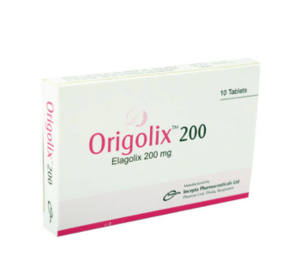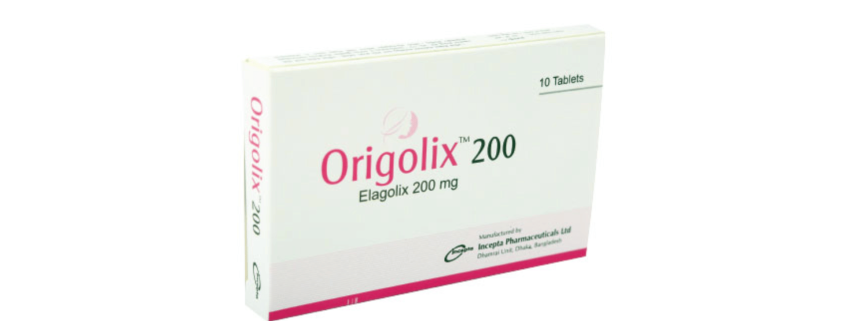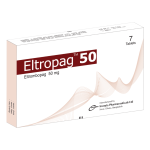OrigolixT(Elagolix 150 & 200 mg Tablet)
Therapeutic Group: Gynaecological

Presentation
OrigolixTM150: Each Tablet contains Elagolix Sodium INN equivalent to Elagolix 150 mg. OrigolixTM200: Each Tablet contains Elagolix Sodium INN equivalent to Elagolix 200 mg.
Description
Elagolix is an orally-administered, nonpeptide small molecule gonadotropin-releasing hormone (GnRH) receptor antagonist that inhibits endogenous GnRH signaling by binding competitively to GnRH receptors in the pituitary gland Label. Administration of elagolix results in dose-dependent suppression of luteinizing hormone (LH) and follicle-stimulating hormone (FSH), leading to decreased blood concentrations of the ovarian sex hormones, estradiol and progesterone.
Indications
Elagolix is indicated for the management of moderate to severe pain associated with endometriosis.
Dosage & Administration
• Exclude pregnancy before starting Origolix or start Origolix within 7 days from the onset of menses.
• Take Origolix at approximately the same time each day, with or without food.
• Use the lowest effective dose, taking into account the severity of symptoms and
treatment objectives
• Limit the duration of use because of bone loss
Normal liver function or mild hepatic impairment:
150 mg once daily for up to 24 months or
200 mg twice daily for up to 6 months if patients has coexisting condition like Dyspareunia.
Moderate hepatic impairment: 150 mg once daily for up to 6 months.
Side Effects
Most common adverse reactions (>5%) in clinical trials included hot flushes and night sweats, headache, nausea, insomnia, amenorrhea, anxiety, arthralgia, bone loss, depression-related adverse reactions and mood changes.
Precautions
Bone Loss: Dose- and duration-dependent decreases in bone mineral density (BMD) that may not be completely reversible. Assess BMD in women with additional risk factors for bone loss
Reduced Ability to Recognize Pregnancy: Elagolix may alter menstrual bleeding, which may reduce the ability to recognize pregnancy. Perform testing if pregnancy is suspected. Discontinue if pregnan- cy is confirmed
Suicidal Ideation and Mood Disorders: Advise patients to seek medical attention for suicidal ideation, suicidal behavior, new onset or worsening depression, anxiety, or other mood changes
Hepatic Transaminase Elevations: Dose-dependent elevations in serum alanine aminotransferase (ALT). Counsel patients on signs and symptoms of liver injury
Potential for Reduced Efficacy with Estrogen-Containing Contraceptives: Use non-hormonal contraception during treatment and for one week after discontinuing Elagolix
Use in Pregnancy & Lactation
Exposure to Elagolix early in pregnancy may increase the risk of early pregnancy loss. Use of Elagolix is contraindicated in pregnant women. Discontinue Elagolix if pregnancy occurs during treatment. The limited human data with the use of Elagolix in pregnant women are insufficient to determine whether there is a risk for major birth defects or miscarriage. Although two cases of congenital malformations were reported in clinical trials with Elagolix, no pattern was identified and miscarriages were reported at a similar incidence across treatment groups. There is no information on the presence of elagolix or its metabolites in human milk, the effects on the breastfed child, or the effects on milk production.
There are no adequate animal data on the excretion of Elagolix in milk. The developmental and health benefits of breastfeeding should be considered along with the mother’s clinical need for Elagolix and any potential adverse effects on the breastfed child from Elagolix.
Use in Special Populations
No dose adjustment of Elagolix is required in women with any degree of renal impairment or end-stage renal disease (including women on dialysis)
No dosage adjustment of Elagolix is required in women with mild hepatic impairment.
Use in Children
Safety and effectiveness of Elagolix in patients less than 18 years of age have not been established.
Drug Interaction
Elagolix may decrease plasma concentrations of drugs that are substrates of CYP3A because Elagolix is a weak to moderate inducer of cytochrome P450 (CYP) 3A. Elagolix may increase plasma concentrations of drugs that are substrates of P-gp (e.g., digoxin) because Elagolix is an inhibitor of efflux transporter P-glycoprotein (P-gp).Elagolix is a substrate of CYP3A, P-gp, and OATP1B1. Concomitant use of Elagolix 200 mg twice daily and strong CYP3A inhibitors for more than 1 month is not recommended. Limit concomitant use of Elagolix 150 mg once daily and strong CYP3A inhibitors to 6 months. Co-administration of Elagolix with drugs that induce CYP3A may decrease Elagolix plasma concentrations. The effect of concomitant use of P-gp inhibitors or inducers on the pharmacokinetics of Elagolix is unknown. Co-administration of Elagolix with drugs that inhibit OATP1B1 may increase Elagolix plasma concentrations. Concomitant use of Elagolix and strong OATP1B1 inhibitors (e.g., Cyclosporine and Gemfibrozil) is contraindicated.
Over Dose
In case of overdose, monitor the patient for any signs or symptoms of adverse reactions and initiate appropriate symptomatic treatment, as needed.
Commercial Pack
OrigolixTM150: Each box contains 1 blister strip containing 10 tablets.
OrigolixTM200: Each box contains 1 blister strip containing 10 tablets.



